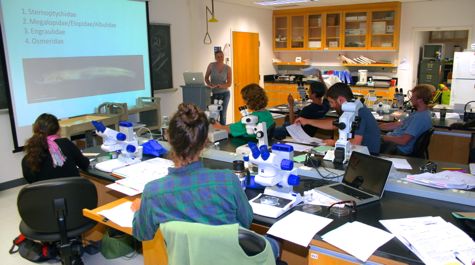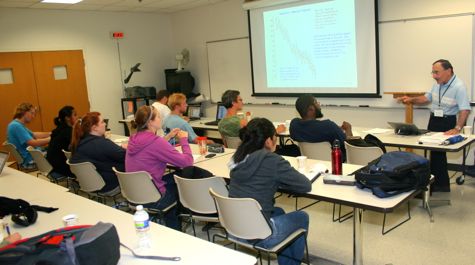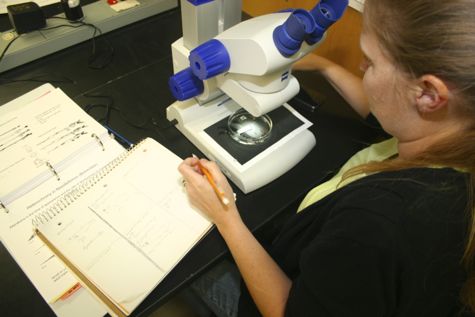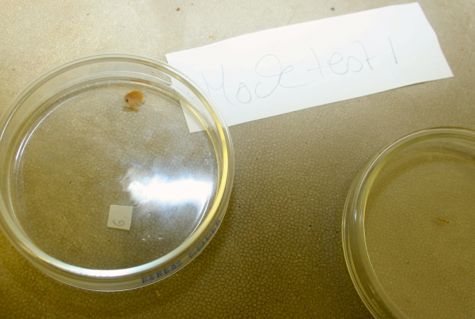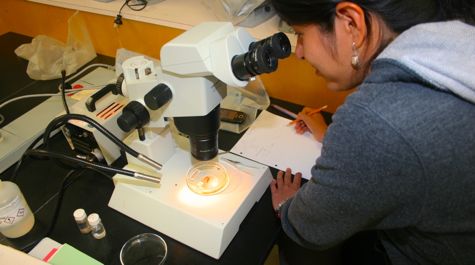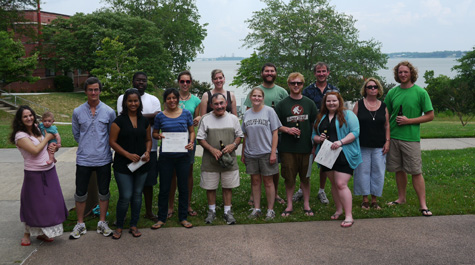With fish, bigger isn’t always better
Course at VIMS gives students knowledge of tiny larval fishes
When it comes to fish, most people would agree that bigger is better—whether for the fry pan, bragging rights, or a wall mount. But for the last three weeks, a group of students at the Virginia Institute of Marine Science have focused hours of attention on fishes no larger than a thumbnail.
The 12 students—from William & Mary’s School of Marine Science at VIMS, 2 other U.S. universities, and marine institutions in Denmark, El Salvador, Israel, and Jamaica—are enrolled in “Early Life History of Marine Fishes,” an intensive graduate-level course that focuses on the anatomy, physiology, and ecology of larval fishes.
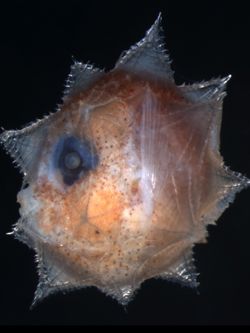
The course is co-taught by former VIMS post-doctoral researcher Dr. Nalani Schnell and professor Ed Houde of the University of Maryland Center for Environmental Science (UMCES). Four other experts in fish development, classification, and ecology serve as guest lecturers: VIMS scientists Dr. Troy Tuckey and Dr. Jan McDowell, VIMS professor John Graves, and UMCES professor Dr. Elizabeth North.
Schnell says that “Many people aren’t aware that fish even have a larval stage,” adding “That’s unfortunate, as fish larvae are not only beautiful but are an extremely important part of the life history of these organisms.”
Tuckey, who manages the day-to-day operation of VIMS’ Juvenile Abundance Monitoring surveys, says that being able to identify larval fish is an essential skill for fisheries scientists and management. “Knowing the abundance of different larval and juvenile fishes plays a key role in managing the adult populations targeted by commercial and recreational anglers,” he says. “All else held equal, a strong class of young-of-the-year fish portends banner times for anglers down the road.”
Schnell and Tuckey marvel at the stark environmental differences encountered by larval versus adult fishes. “Larvae are very susceptible to being eaten by larger fishes and other creatures like jellyfish,” says Schnell. “Some larvae exhibit long spines on head and fins—presumably to make them bigger than the mouths of their predators.”
“For organisms this small,” adds Tuckey, “water has the viscosity of molasses, requiring a lot of energy just to move. After using up all the energy they got from their yolk sac, fish larvae have to learn and practice effective feeding strategies so that they can grow bigger quickly, before they get eaten by something larger."
The course participants also marvel at how different the larval and adult forms of a single species can be, citing ocean sunfish, flounder, and whalefishes as notable examples. One student, Dr. Sarah Huber, notes that “Whalefish larvae are so different from the adults that they had long been classified as a separate family. Not a different genus or species, but a different family.”
When asked which of the larval fish is her favorite, student Cindy Marin Martinez says “I don’t have a favorite—there is too much variety and each one has their own features that makes them beautiful or different. It’s like being a parent—you do not have a favorite son or daughter, you love them all.” Martinez, a native of El Salvador, plans to enroll in the graduate program at VIMS this fall.
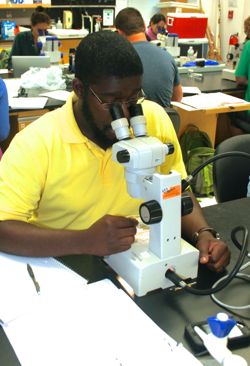
Diverse reasons
Overall, the students’ reasons for taking the course are as diverse as the fish they study. Huber’s interest in the course relates to her job as Collection Manager for the Nunnally Ichthyology Collection at VIMS, where she will soon begin a project to sort, identify, and catalog all of the larval fishes the collection holds.
Nasheika Guyah, a Master’s student at the University of the West Indies, Mona campus, is taking the course to help complete her study of fish larvae in marine reserves across Jamaica, while Naama Kimmerling, a Ph.D. student at Ben-Gurion University of the Negev in Beer-Sheva, Israel, is studying how the larvae of coral reef fishes are distributed in the Red Sea.
Says Kimmerling, “For studying this topic, I have to first identify the larvae in my samples. However, no one in Israel specializes in larval-fish taxonomy—and to make things more difficult—there is no identification guide for this area. Therefore this course is extremely important for me.”
Brandon Conroy, a Ph.D. student in the School of Marine Science at VIMS, will use the knowledge he gains during the course to help analyze samples he’s collected during his dissertation research on the Amazon plume. He says, “I’d like to report on the diversity of the fish larvae in my research, but had very limited knowledge of larval taxonomy prior to this course.”
Like many of the other students, Daniel Jiro Ayala says the course is just the latest chapter in a life-long interest in all things fishy. Jiro Ayala, a Ph.D. student at Denmark’s National Institute of Aquatic Resources, says “I had a seven year period as a youngster when I went fishing with my dad at least once a week, getting him up before school so we could go fishing before I had to go to classes. Later I did a few Master's theses in marine biology and sustainable use of marine resources, so this course is just a natural continuation of this process.”
Jiro Ayala says the course has given him ”insight into larval fishes, their dynamics and wonderous wonders.” Guyah adds, “My favourite part was learning about the diversity of the larvae in the different families and about their varied adaptations to survive. [The course] was exhaustive and exhausting, but it’s worth it at the end.”
Olney Teaching Collection
The course builds on a teaching collection created by the late VIMS professor John Olney, Sr. Schnell says the collection—which now includes representatives from 197 different fish families—is one-of-a-kind. “There are a few other comparable collections around the world,” says Schnell, “but none are available for use in the classroom.”
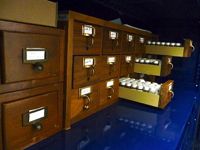 VIMS laboratory specialist Pat Crewe is responsible for laying out and re-filing the samples for each of the course’s 13 laboratory sessions—no easy task given their diminutive size, broad diversity, and alphabet soup of taxa names—from Albuliformes to Zoarcoidei, with Batrachoidiformes, Callionymidae, Eurypterygii, Gasterosteiformes, Lampridiformes, Ostariophysi, Protacanthoptergyii, Scombrolabracoidae, and 38 other multi-syllabic names in the mix.
VIMS laboratory specialist Pat Crewe is responsible for laying out and re-filing the samples for each of the course’s 13 laboratory sessions—no easy task given their diminutive size, broad diversity, and alphabet soup of taxa names—from Albuliformes to Zoarcoidei, with Batrachoidiformes, Callionymidae, Eurypterygii, Gasterosteiformes, Lampridiformes, Ostariophysi, Protacanthoptergyii, Scombrolabracoidae, and 38 other multi-syllabic names in the mix.


